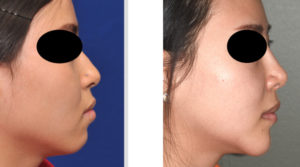While one could argue that no individual really sees themselves in a true profile view, that is how the rest of the world does however. (actually a quarter profile view to be accurate) In a profile view, the most important facial prominences are the nose and the chin and to some degree the neck angle. The most horizontally protruding points of the facial profile (nasal tip, chin point, and neck angle) can be traced with a set of lines from the forehead to create a geometric form. The more convex this geometric outline becomes, the better balanced the facial profile (and the face) is.
The key elements of this facial convexity are the nose and chin points. They represent the ‘ying and the yang’ of the facial profile. Ideally, the base of the nose and the chin should lie on a similar vertical line. Often, however, the nose is in front of the chin due to a larger nose and a smaller chin. (increasing facial convexity and facial imbalance) Therefore, the combination of a rhinoplasty that reshapes and reduces the size of the nose and a chin implant which brings it forward is a classic facial combination and the most commonly performed ‘facial duet’.
Often times, patients do not envision the need for a chin implant with their rhinoplasty procedure. This is where facial computer imaging, which is most accurate in profile assessment and changes, is so valuable. Computer imaging also empowers the patient so they can determine if the combination of a rhinoplasty and chin augmentation is better than a rhinoplasty alone.

Dr. Barry Eppley
Indianapolis, Indiana


